In Banjul, the capital of The Gambia, daily life spills into the open-air markets where narrow aisles overflow with produce, textiles, and the chatter of vendors. The stalls form more than a commercial center; they serve as a stage for the rhythms of the city, where food, trade, and conversation intertwine in a tapestry of community life.
Albert Market, the city’s busiest hub, embodies this vitality. Crowds press between stands stacked with mangoes, peppers, and bundles of leafy greens. Spices release their sharp aromas into the humid air, mingling with the scent of smoked fish. The clamor of bargaining blends with bursts of laughter as vendors call out prices, their voices competing with the shuffle of sandals across dusty floors.
Beyond food, the market is also a gallery of Gambian craftsmanship. Bolts of fabric unfurl in rich colors—indigo batiks, bold wax prints, and flowing boubous dyed in vibrant patterns. Each piece carries a cultural narrative, shaped by artisans whose skills have been refined over generations. The textiles, often displayed in dramatic swathes, catch the light and the attention of those weaving through the stalls, reflecting both fashion and heritage.
Street food anchors the market’s social rhythm. Benechin, a one-pot dish of rice and fish, sizzles in wide pans, while yassa, marinated chicken simmered with onions and lemon, steams from iron pots. Vendors prepare akara—deep-fried bean cakes—by hand, passing them to customers wrapped in paper with practiced efficiency. These meals, quick to serve and rich in flavor, sustain shoppers and traders alike while preserving culinary traditions rooted in family kitchens.
The marketplace also acts as a forum of exchange beyond goods. Conversations over prices slide easily into discussions of politics, family news, and local gossip. The atmosphere underscores a Gambian trait widely remarked upon by visitors and scholars alike: an open, communal warmth that binds even fleeting encounters with a sense of hospitality.
Economic stakes in the markets remain significant. For many families, stalls provide a primary source of income, and the purchase of produce, textiles, or crafts directly supports local livelihoods. In a city where formal employment can be scarce, the marketplace doubles as both an engine of survival and a cultural repository.
Though modest in scale compared to the metropolises of neighboring countries, Banjul’s markets reveal much about the nation itself: resilience in commerce, artistry in craft, and conviviality in exchange. In their crowded lanes, where past and present meet, the pulse of Gambian life beats strongest.


